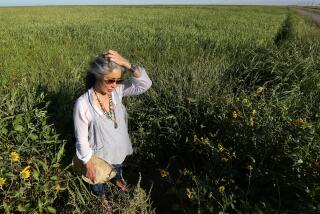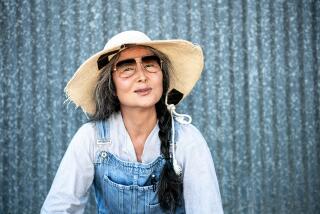GLOBAL AGRICULTURE : Culture : Rice No Longer Equals Life in Japan : Gradual opening of the market seals the fate of traditional system. Changes in society already have drastically cut consumption.
- Share via
TOKYO — “Japan still has the character of a farm village, with a very consensus-oriented society,” said Keizo Mochida, an agricultural economist at Wako University in Tokyo. “Rice is the bottom line in that, because to grow rice you have to cooperate with others for irrigation. Rice created the foundation of Japanese society.”
In daily life, the central role of rice is fading. The average person consumes 150 pounds of the grain each year, but that is down 40% since 1962. The percentage of Japan’s population in farm households has fallen from 41% in 1955 to 13% today. The average age of farmers is now 56, up from 37 in 1960.
Mochida sees change reflected in his students, who prefer whiskey or beer to sake, the Japanese rice wine. “Overall, Japanese characteristics are disappearing,” he said. “You can call it internationalization. . . . But we want rice to survive. It symbolizes Japanese scenery and an attachment to the land. We don’t want small mountain villages to die.”
Remote villages, where old ways of life change most slowly, have faced decline since the end of World War II. Even when sons take over the family land, they often have trouble finding wives willing to endure the rigors of farm life. The only thing keeping many mountain villages alive is the outmoded national rice policy, which keeps prices at 10 times the world level. The policy has also brought stability--for better or worse--to less isolated areas, as people hang on to small holdings they otherwise might sell.
The old system might someday have collapsed under the weight of its own inefficiencies. But its fate was sealed by Japan’s agreement in December, in a key contribution to a new global trade accord, to gradually open its rice market.
Then-Prime Minister Morihiro Hosokawa described the move, taken under tremendous pressure from the United States, a top rice exporter, as a “painful, heartbreaking decision.”
After nearly three decades of declaring that Japan would not import even a grain of rice, Tokyo was forced in rapid succession last year first to approve emergency imports--because of a production shortfall caused by bad weather--and then to agree that beginning in 1995 it would import a minimum of 400,000 tons, with that figure rising to 800,000 by the year 2000. Quotas will ultimately be replaced by gradually reduced tariffs, further opening the market to international competition.
So far, the government, which controls all rice imports, marks up foreign rice prices close to the level at which domestic rice is sold. This ensures that Japanese rice remains most popular, and provides profits that can be used to subsidize farmers. But eventually foreign rice will enter Japan at prices that undercut domestic varieties.
Everyone in Japan, from the remotest hamlets to the halls of Parliament, is affected by the upheaval. Farmers ponder the future of their children, their land and their villages.
“How will the people who leave farming find other jobs?” asked Kenetsu Sasaki, 44, a farmer in Tominaga Higashi, 25 miles from the northeastern city of Sendai. “People here can commute to the city. But remote communities will collapse.”
There are only six full-time farmers left in his hamlet of 48 homes. But almost all families have kept their land, taking other jobs and growing rice on weekends. Sasaki farms 19 acres, a large spread by Japanese standards, with 97% of his land in rice. Ten years from now, through leasing or possibly purchasing land from others, he hopes to have assembled nearly 40 acres.
He hopes his 10-year-old son will follow him into farming, but figures he would need to work 75 acres to profit in the face of future foreign competition. Except in Japan’s less-populated northern island of Hokkaido, farming on this scale--while very modest by American standards--has been virtually unimaginable in Japan. Japanese rice fields typically are divided into tiny plots of less than half an acre, surrounded by raised walkways that hold back water and allow for terracing of hillsides. The average Japanese rice farm is just under 2 acres, compared to 280 acres in the United States. Labor hours per acre are about 24 times greater in Japan.
The result is that producing rice here costs more than $2,000 a ton, compared to $200 a ton in the United States.
The roots of this system go back to a poor harvest in 1917. Production fell just 7%, but rice was subject to rampant speculation, hoarding and market cornering in the unregulated capitalism of those days. By July of 1918, the price of rice had doubled.
Angry women in a fishing village on the Sea of Japan stormed rice stores in a protest that triggered rioting nationwide. The most serious was in Osaka, where hundreds of thousands took to the streets. The Rice Riots lasted 50 days, involved 1 million people, and were suppressed by 50,000 soldiers. They led to a new Rice Law that provided for government intervention in rice markets.
Government control of rice was further strengthened in 1942 by the wartime Food Control Law. This law, which remains in effect today, was designed to ensure that affordable rice was available to consumers and that farmers received sufficient payment to ensure production. Until the mid-1950s it worked mainly to consumers’ benefit. But then, as Japan achieved self-sufficiency in rice, it became a way for the Liberal Democratic Party, which governed from 1955 to 1993, to funnel wealth to the countryside. The farm lobby became a key ingredient in the LDP’s lock on power. No prime minister dared reform the system or allow rice imports.
Because even part-time rice farming remained profitable, farm families were unwilling to sell their land to their neighbors, which would have allowed the creation of larger, more efficient farms--but also might have accelerated the depopulation of the countryside. Last summer, reformers headed by Hosokawa took power just as Japan experienced its worst rice harvest in decades. Emergency rice imports broke the spell of the old “not one grain” mantra, and Tokyo capitulated in the December trade talks.
Whereas just two years ago analysts saw the Food Control Law as an unassailable sacred cow of Japanese politics, Agriculture Ministry officials now indicate that a draft bill abolishing the law is likely to be introduced to Parliament this fall. New legislation would aim at freeing rice distribution and encouraging farmers to assemble larger, more economical plots of land. In essence, Japan’s large and remarkably open black market on rice would be legalized and the countryside would be commercialized.
Such a result would be a victory for people like the flamboyant Isonobu Kawasaki, Japan’s most famous accused rice criminal, who has long claimed that the current system does more to hold back farmers than to help them. Kawasaki’s brush with the law began in 1982. By then, Japan’s capacity for rice production exceeded demand and the government was paying farmers to hold part of their land out of production, a program that continues today. Participation is mandatory, but Kawasaki refused. The official agricultural cooperative handling rice purchases under the Food Control Law retaliated by refusing to buy his crop. Kawasaki responded by illegally selling his rice directly to consumers.
Kawasaki’s black market shop prospered, and soon he was buying other farmers’ crops for resale. Thousands of others quietly took the same path. It is now estimated that out of the typical annual production of 10 million tons of rice, 6 million is distributed through legal government channels, 2 million is consumed by farmers and their relatives, and 2 million enters the black market. Kawasaki, 58, who comes from the part of Japan where the 1918 Rice Riots began, is now being prosecuted for illegal rice sales, the first and only such prosecution in more than a decade.
Yoshiyuki Hoshino, a Tokyo rice retailer, thinks the changes promoted by rebels like Kawasaki and by pressure from Washington mean the ultimate destruction of specialty shops like his, an open-fronted wooden storefront stacked with rice sacks that evokes the aura of a simpler Japan. Resigned to that fate, Hoshino has none of the traditional expectations that his son should take over the shop.
“In the past, we thought of rice and life as being the same,” he said. “Now my own son eats bread for breakfast and goes off to work. Rice meals take time. It’s not just Japan, the whole world is progressing. There’s nothing you can do about it. So long as a few people preserve traditional culture, isn’t that OK? Rice won’t disappear.”
Times researcher Chiaki Kitada in Tokyo contributed to this report.
More to Read
Sign up for Essential California
The most important California stories and recommendations in your inbox every morning.
You may occasionally receive promotional content from the Los Angeles Times.










